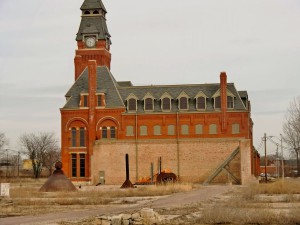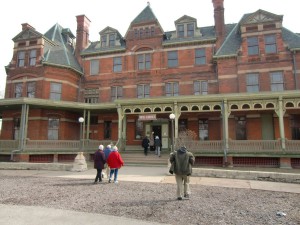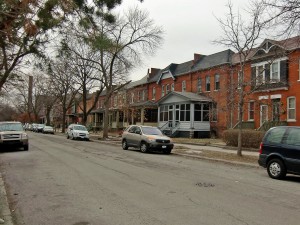IN SEARCH OF SNOW – ON TO MICHIGAN
IN SEARCH OF SNOW
This is the fifth in a series of articles about traveling by rail in search of snow
ON TO MICHIGAN
By Charles N. Stevens
Photos by Dolores Seidman
The wind bites as we leave the Palmer House Hotel, the temperature a chilly 27 degrees. The murky sky is covered over with a veil of high clouds, a halo around the sun. Heavily bundled people walk briskly along the walk ways, leaning forward against the wind and a desire to get out of the cold. The sounds of traffic and the roar of the elevated railway add to the drama.
Now in a warm bus, we’re on our way to the remains of the Pullman works where Pullman cars were once built for railroads all over the United States. We skirt along Lake Michigan, looking very dark under the dull sky then breeze by Soldier Field, home of the Chicago Bears football team. Now on the freeway, we pass miles of railroad yards and commuter lines, reminding me of Carl Sandberg’s line in his poem, “Chicago.”
“Player with Railroads and the Nation’s Freight Handler”
Once at the town of Pullman, we walk out into the area where hundreds of Pullman cars were once manufactured for the nation’s railroads, but now looking more like an archeological site with its old concrete foundations, aging, now empty brick buildings and dirty skylights letting in the feeble light of the day.
What is most amazing about the Pullman Works is that a city built by George Pullman for his workers grew up around it. This planned community was constructed from 1880 to 1885 on 4000 acres of open land 12 miles south of Chicago. The town provided superior amenities such as parks, stores, churches, schools, a bank, library and health services. Once slated for demolition, these substantial brick homes and apartments are still vital and are lived in today. A grand hotel for visitors and a church also stand today and are still used. We walk into the old Queen Ann style hotel, the Hotel Florence, marveling at its spaciousness and original furnishings.
After finishing with historic Pullman, we head for Hammond, Indiana where we will board our train for Michigan. We wait in the warmth of the station until we see the headlight of our train, the Wolverine, appear down the tracks. We’re soon on our way, the scene outside our window one of old steel plants, many now defunct as much of our steel is manufactured in Asia. Our first stop is in Michigan City, Indiana with its bare trees, dry grasses and winter-dead lawns, here and there a snow patch. We finally slip into Michigan itself, passing the common sight of farm land—fields, farm houses and silos, almost like Iowa again. Flocks of gulls gather at a half-frozen pond. Snow on the ground increases as we travel north, everything we see appearing plain, dormant and dead, waiting for the warmth of spring to revive it.
We notice as we pause at cities like Niles and Kalamazoo that very few people are outside, most staying indoors to avoid the cold. Rock salt is spread on some of the station platforms to deal with the snow and provide a better footing. Some of the old train stations, most built like fortresses, are not in use anymore, probably too difficult to maintain. Near Kalamazoo our train skirts the campus of the Western Michigan University. We pass unusual sights—a high school athletic field covered with snow, a picnic table in a park of winter-dead trees, snow all around it, a picnic under leafy green trees months away.
Our train pauses at Battle Creek, home of the Gerald Ford Presidential Library. We note a colorful playground in a snowy park and piles of dirty snow scraped off the streets by snow plows. At Albion we pass Albion College where deer forage in the snow close by. As we streak by forests outside of town, the thousands of bare branches and twigs give an almost smoky appearance. Near Jackson wild turkeys, contrasting with the whiteness of the snow, hunt for what they can scratch up. Deer, startled by our train, run through the snow, kicking it in all directions. Another interesting sight is that of gravestones in a cemetery protruding from the snow. The frozen landscape that passes by our window is so different, yet fascinating to us as native Californians.
The tracks now run along the Huron River where we see Canada geese resting on an icy shelf along the river’s edge. After leaving Ann Arbor, home of the University of Michigan, the temperature 26 degrees, we arrive at Dearborn, our final destination. Outside in the cold again, we walk across the station platform, our shoes crunching rock salt and crispy ice. It’s dark by the time we are transported to the Dearborn Inn, a new and very attractive hotel where we are to stay for two nights.
Hungry, Dolores and I have excellent dinners in a cocktail lounge downstairs in the basement. She has a tasty chicken Caesar salad. I dine on hot meatloaf and mashed potatoes, just right for me after looking out on snow, ice and bare trees all day long.

The factory and clock tower where hundreds of Pullman railway cars were built remain.

The once grand Florence Hotel in Pullman housed guests to the town and factory.

The old town that George Pullman built still serves as a vital residential community.

On our way again towards Michigan, the landscape as seen through our train window becomes much snowier.



